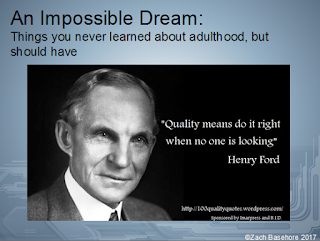I left a comment at a very interesting blog post at
http://www.ivigilante.com/where-rationality-ends/. Here's what I wrote:
An interesting article! I think that you brought up rationality in a
sense that has more to do with academic notions of what is “ideal” than
with the real world. It’s understandable, since most formal education
(particularly in economics departments!) focuses on this notion!
Herbert Simon was, as far as I’m aware, the first academic to point
out that expecting people to act ‘rationally’ is futile. He won a Nobel
Prize for his work on bounded rationality, too, so it’s not like his
work went unrecognized. A brief summary: http://www.economist.com/node/13350892
As this page correctly observes, people’s behavior often fails to adhere to even the
most basic principles of logic, which leaves humans looking pretty
stupid IF you believe that logic–i.e. ‘rationality’–is the best standard
to which we should compare behavior.
But Gerd Gigerenzer and others (including me) argue the opposite!
Rather than saying, ‘Gee, people are pretty dumb because they don’t make
decisions the way a computer would make a decision,’ we argue instead
that people use shortcuts that are typically well-suited for the real
world of vast uncertainty and severe time pressure.
Some interesting reading on Gigerenzer’s approach, which he calls “ecological rationality:” https://hbr.org/2014/06/instinct-can-beat-analytical-thinking and https://www.edge.org/conversation/gerd_gigerenzer-smart-heuristics
In the instance of the gas station that you described above, I’d say
you were acting in an ecologically rational manner, probably using a
heuristic. I’d guess that your deliberation went something like this:
“This old-timey gas station has ridiculously long lines. I hate long
lines! Screw it, I’ll go elsewhere and pay a bit more for my gas. The
savings of about $1.00 per fill-up isn’t worth my time and aggravation.”
A standard economic model would require that you sit down and
calculate whether the savings of $1 or $2 is actually worth your time
and aggravation. Which would, of course, require that you assigned a
numerical value to your aggravation, knew how much time you’d spend
waiting, and how much of that waiting time you’d actually spend on side
hustles (vs. something unproductive), how much money you’d make from the
time spent on your side hustle, etc…
When it’s spelled out like that, it becomes painfully obvious that nobody behaves like “homo economicus,”
because performing such actions is, in itself, terribly inefficient–not
to mention far more imprecise than big-time thinkers would like to
admit [i.e. how much IS your aggravation worth? And what if you estimate
a 15-minute wait, but it’s actually a 25-minute wait, which causes
extra frustration? How much extra frustration would that cause, and what
negative effects would that stress have on your health? And, more to the
point, how much would it cost to address those negative health effects?
Because, remember, we need numbers in order to make the equation work…].
So, to the point of your article: if you buy into Gigerenzer’s
notions, rational thought often DOESN’T require complexity–as long as
you’re holding people to the standard of ecological rationality, rather
than logical-mathematical rationality.
The example above illustrates how ridiculous it is to expect people to make 'rational,' calculated decisions
every time they're faced with a choice. Can you imagine stopping to do a calculation like this every time you had to do something?! You'd never accomplish anything, because you'd suffer from "paralysis by analysis."
Thus, assuming that your goal is to be productive, it is therefore irrational to be rational!!!
To use the above example of waiting in a long line in order to save $0.10 per gallon on gas, you'd have to quantify everything: how much is your time worth? How much is your frustration worth? How much gas would your car would use at idle while you wait in line for a pump to open up? What is the 'opportunity cost' of spending time waiting in line for a pump, waiting to pay at the counter, and trying to merge back onto the highway? Furthermore, as another commenter noted at the above article by
I, Vigilante, what is the potential cost—in money, in time, and in trouble—of credit-card skimming, or the risk of total identity theft?
By the very nature of calculation, you need to fill in numbers here. But how can you quantify frustration in monetary terms? The very act of filling in this kind of equation requires enough guesswork to make the entire procedure an exercise in futility!
That's a hidden fact about math: it requires certainty about each term in the equation. Once you introduce guesswork, the equation becomes meaningless. It will still give you an answer, but to quote a popular proverb on the subject: "Junk in, junk out."
Essentially, acting in an ecologically rational manner is
to adapt your behavior to suit the situation. Since every situation has different characteristics, it is foolish to behave the same way in all situations
!
There are times in which deliberation and care are necessary before embarking on a course of action; there are other times in which quick, decisive action is needed. It is therefore impossible, on a practical level, to know in advance which kind of approach is best for solving a particular problem. One must first identify the nature of the problem, and any important features that may make this particular problem unique/different from similar situations one has already faced.
Academics tend to dislike such arguments, since this renders it impossible for researchers to determine in advance what the "correct" answer should be. After all, a researcher needs to present his or her ideas to skeptical peers! So it is far more defensible to tell your peers: "The correct answer is X, because this equation, based on principles of formal logic, has determined that the correct answer is X."
After all, the above approach has the appearance of airtight inevitability! If you say, "This equation yields X, therefore, the correct answer is X," you're much less likely to spark a heated debate than if you introduce the obvious subjectivity of "Situation P requires this equation, whereas Situation Q requires that equation. Since here, we have Situation P, this equation is necessary, so the correct answer is X. But if we changed these features, we'd have Situation Q, and the correct answer would be Y." An audience member could easily challenge you by objecting that we don't really have Situation P—we actually have Situation Q, or maybe Situation R. This debate could derail your entire presentation and make you look silly in front of a room full of your peers at a conference!
But is the point of research to avoid disagreement, or to advance knowledge?...
My overarching point is this: when academic research demonstrates that most people arrive at the wrong answer to a question, the participants' errors may be an artifact of the research process, NOT something inherently wrong with the human mind!
Next time a researcher tries to tell you that you're irrational, you shouldn't necessarily believe it...



















